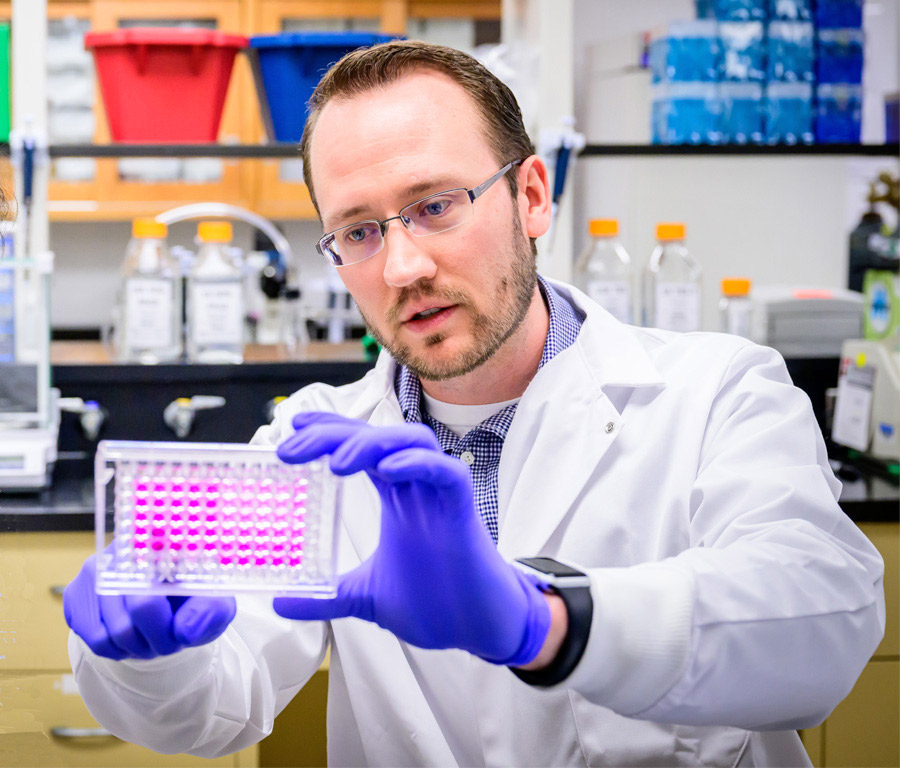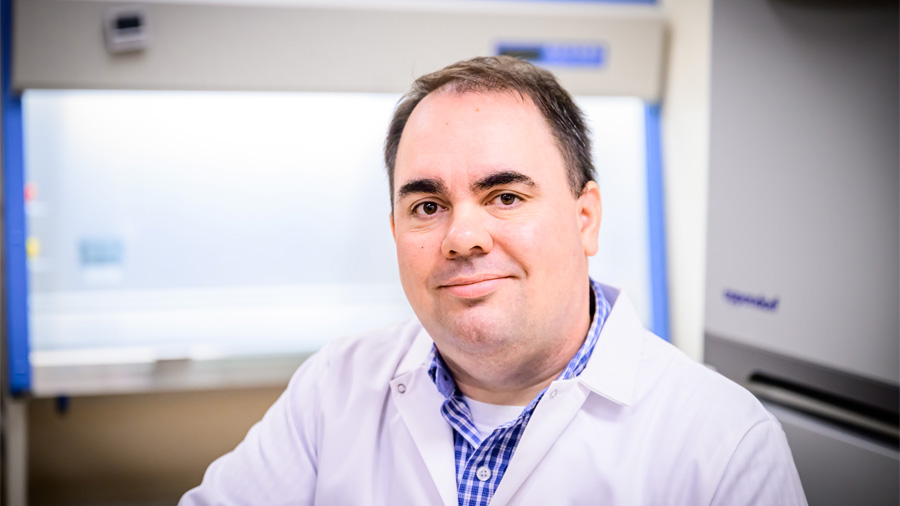Dr. Weiping Zhang, professor in the Department of Pathobiology, was recently awarded a five-year, $5.6 million R01 grant from the National Institutes of Health (NIH) to optimize a promising vaccine against enterotoxigenic Escherichia coli (ETEC). Worldwide, enterotoxigenic strains of E. coli bacteria (i.e., the strains producing toxins that affect the intestines) are responsible for over 220 million diarrheal cases and 100,000 deaths annually.
Dr. Zhang previously received NIH R01 funding in 2016 and 2019 for the development the ETEC vaccine, called MecVax. The new grant will refine the formulation of MecVax and advance it toward large-scale production. Partner institutions on the grant include Johns Hopkins University, Baltimore, Md., and Advanced Bioscience Laboratories, a Maryland-based vaccine development company.
“Since the late 1980s, researchers have been working to develop a vaccine against enteric E. coli, and still there is no licensed vaccine product on the market,” said Dr. Zhang. “That’s in large part due to the divergence of this bacterium: there are so many strains that produce different virulence factors, it’s challenging to make a single effective vaccine.”
A Novel Vaccine Approach
MecVax was created using an innovative platform dubbed “MEFA,” for multiepitope fusion antigen. MEFA technology was developed by Dr. Zhang’s lab and first published in 2013. It is the leading product globally for overcoming the problem of multivariant strains of a pathogen.
“The MEFA technique makes it possible to create one vaccine that is effective against many strains,” explained Dr. Zhang.
Using this platform, Dr. Zhang’s lab constructed two proteins, one that targets ETEC adhesins (structures on the bacteria’s surface that enable them to adhere to the lining of the digestive system) and one that fights toxins produced by the bacteria.
This vaccine takes into account the two phases of infection by ETEC. First, the bacteria must be able to attach to the intestine (adhesion), and second, they must be able to deliver the toxins they produce, which cause the disease.
Weiping Zhang | Department of Pathobiology
One Gene, Seven Strains
“This vaccine takes into account the two phases of infection by ETEC,” said Dr. Zhang. “First, the bacteria must be able to attach to the intestine (adhesion), and second, they must be able to deliver the toxins they produce, which cause the disease.
“If you can stop them from adhering, they can’t cause disease; if you can stop them from producing toxins, they can’t cause disease.”
The genius of the vaccine is in creating a single gene that targets seven adhesins produced by the ETEC strains that are responsible for two-thirds of all clinical cases of ETEC illnesses. The second protein constructed for the vaccine neutralizes two toxins found in all ETEC strains. Thus, if a vaccinated individual is infected by a strain other than the seven targeted by the vaccine, there will still be protection against the symptom-causing toxins produced by the infecting strain.
In preclinical studies done with pigs and rabbits, the vaccine was 100% effective in preventing watery diarrhea.
The Latest Grant
At present, the vaccine has only been produced in the laboratory.
“We currently synthesize the proteins in the lab,” says Dr. Zhang, “so to bring the vaccine to commercialization, we need to find a way to produce them on a mass scale.”
The latest NIH funding supports this goal. The Zhang lab will focus on identifying the most appropriate antigen doses as well as adjuvants, buffers, and shelving conditions to optimize performance of the vaccine. Partners at Advanced Bioscience Laboratories and Johns Hopkins University will develop and test manufacturing processes to ready the vaccine for the FDA’s pre-Investigational New Drug Application.
ETEC Research Began in Pigs
Initially, Dr. Zhang was interested in stopping diarrheal disease that sickened weaned pigs, causing substantial economic losses to the pork industry. Dr. Zhang received funding from the US Department of Agriculture to study the problem.
As his understanding of ETEC deepened, Dr. Zhang realized that the mechanisms of disease were the same in pigs and in humans. ETEC bacteria are a top cause of children’s diarrhea and travelers’ diarrhea.
Dr. Zhang’s research focus expanded, and his work attracted funding from the Gates Foundation (through PATH) and NIH to tackle the problem of ETEC in people. His work toward a vaccine for the pork industry continues in parallel with development of the human vaccine.
Next Steps for MecVax
A safe and effective ETEC vaccine offers hope for greatly improved public health. In countries with poor sanitation, diarrhea is the second leading cause of death and a major contributor to stunting and poor cognitive development in children under 5 years of age. Additionally, ETEC illnesses exact a large economic toll in lost productivity and health care costs, particularly for military personnel and vacationers in countries with poor sanitation and hygiene.
“When there is poor sanitation, there is a constant cycle of infection due to the bacteria being shed from infected people and entering the water sources or being spread to food and drinking water,” said Dr. Zhang.
Despite its efficacy in studies with mice, pigs, and rabbits, MecVax still has a long row to hoe before it can fulfill its promise of saving human lives and curtailing illness. After the goals outlined in the current NIH grant are achieved, additional toxicology studies must be done before the vaccine can begin safety studies in people. One of the final hurdles will be human clinical trials in the field, likely in the countries most plagued by ETEC illness.
What the Future Holds
“The hope is that MecVax could be on the market within 10 to 15 years,” said Dr. Zhang.
That ambitious timeline would add up to more than 30 years from when Dr. Zhang began to research diarrhea in pigs. While vaccine development follows a meticulous and typically time-consuming path, development of the COVID-19 vaccines presented a notable exception.
“Because the whole world focused resources on one product, it went quickly,” said Dr. Zhang.
“Human vaccine development is a very costly undertaking, requiring at least a $1 billion commitment, which is why governmental funding is so critical,” he added. “For-profit companies cannot afford that sort of investment alone.”
In addition to his MecVax research, Dr. Zhang is working on a combination vaccine to prevent ETEC and two other prominent diarrheal illnesses, cholera and shigellosis (another NIH R01 has been awarded in 2023), that together are responsible for significant mortality and morbidity globally.
Feature photograph by L. Brian Stauffer, News Bureau photographer




